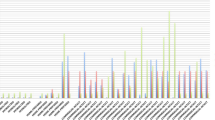Summary
Background. Bacterial translocation from the gut to mesenteric lymph nodes and other extraintestinal sites is an important source of infection in acute pancreatitis. Impaired host immunity is known to promote bacterial translocation. Interleukin-6 (IL-6) is a multifunctional cytokine that regulates the immune response, acute phase reaction, and hematopoiesis.
Methods. Twenty-four mongrel dogs (18–29 kg) were studied in four equal groups. In Groups I and II, acute pancreatitis was induced by direct pressure injection of 4% taurocholate and trypsin into the pancreatic duct at laparotomy. Groups III and IV had only laparotomy. Group I and III dogs were given IL-6 (50 µg/kg/d, sq) daily starting 24 h after operation and Group II and IV dogs received an equal volume of saline administered at similar time. All animals had blood drawn for culture, complete blood count (CBC), platelets, erythrocyte sedimentation rate (ESR), C-reactive protein (CRP), and amylase on d 0, 1, 4, and 7. On d 7, mesenteric lymph nodes (MLN), spleen, liver, pancreas, and cecum were harvested for pathology study and for cultures of aerobic and anaerobic bacteria. Quantitative cecal cultures of aerobic and anaerobic bacteria were obtained.
Results. All Group I and Group II dogs had severe pancreatitis. The increase of plasma CRP in Group I was sustained throughout treatment (1.3±0.3 on d 0 vs 3.1±0.3*, 3.0±0.3*, and 2.9±0.3* and d 1,4, and 7, respectively). Plasma CRP was increased in Group II on d 1 and d 4 (1.3±0.3 mg/dL on d 0 vs 3.6±0.3* mg/dL on d 1, and 3.1±0.3* on d 4, *p<0.05). There were no differences in white blood cell (WBC) count, differential, platelets, and ESR between Groups I and II. Bacterial translocation to MLN was lower in Group I (1/6) than in Group II (6/6) (p<0.05). All 6 dogs in Group II had bacterial spread to distant sites compared to 2 of 6 dogs in Group I (p=0.066). Both MLN and other distant organ cultures were negative in Group III and only 1 of 6 MLN cultures was positive in Group IV.
Conclusions. IL-6 treatment decreases bacterial translocation to MLN and may be beneficial in reducing septic complications in acute pancreatitis.
Similar content being viewed by others
References
Kazantsev GB, Hecht DW, Rao R, et al. Plasmid labeling confirms bacterial translocation in pancreatitis. Am J Surg 1994; 167: 201–207.
Rao R, Kazantsev GB, Hecht DW, et al. Immunostimulation with granulocyte colony-stimulating factor to prevent the septic complications of acute pancreatitis. Surg Forum 1993; 172–173.
Hirano T. Interleukin-6 and its relation to inflammation and disease. Clin Immunol Immunopathol 1992; 62: S60-S65.
Norman J, The role of cytokines in pathogenesis of acute pancreatitis. Am J Surg 1998; 175: 76–83.
Osman M, Jensen SL. Acute pancreatitis: the pathophysilogical role of cytokines and integrins. Dig Surg 1999; 16: 347–362.
Grotz M, Deitch EA, Ding J, Xu D, Huang Q, Regel G. Intestinal cytokine response after gut ischemia: role of gut barrier failure. Ann Surg 1999; 229(4): 478–486.
Rollwagen FM, Li YY, Pacheco ND, Baqar S. Systemic sepsis following hemorrhagic shock: alleviation with oral interleukin-6. Military Med 1997; 162(5): 366–370.
Widdison AL, Karanjia ND. Pancreatic infection complicating acute pancreatitis. Br Surg 1993; 80: 148–154.
Medich DS, Lee TK, Melhem MF, et al. Pathogenesis of pancreatic sepsis. Am J Surg 1993; 65: 46–52.
Wulff K, Sjostrom B. Influence of acute pancreatitis on central hemodynamic, regional blood flow distribution and arteriovenous shunting in the dog. Eur Surg Res 1974; 6: 354–363.
Larvin M, Alexander DJ, Switala SF, McMahon MJ. Impaired mononuclear phagocyte function in patients with severe acute pancreatitis: evidence from studies of plasma clearance of trypsin and monocyte phagocytosis. Dig Dis Sci 1993; 38: 18–27.
Widdison AL, Karanjia ND, Alvarez C, Reber HA. Influence of levamisole on pancreatic infection in acute pancreatitis. Am J Surg 1992; 163: 100–104.
Chaloner C, Laing I, Heath DI, et al. Dysregulation of T cell-Macrophage network in severe acute pancreatitis. Biochem Soc Trans 1993; 21: 451S.
Runkel NSF, Moody FG, Smith GS, et al. The role of the gut in the development of sepsis in acute pancreatitis. J Surg Res 1991; 51: 18–23.
Scheid C, Young R, McDermott R, et al. Immune function of patients receiving recombinant human Interleukin-6 (IL-6) in a phase I clinical study: induction of C-reaction protein and IgE and inhibition of natural killer and lymphokine activated killer cell activity. Cancer Immunol Immunother 1994; 38: 119–126.
Liu Z, Simpson RJ, Cheers C. Recombinant Interleukin-6 protects mice against experimental bacterial infection. Infect Immun 1992; 60: 4402–4406.
Takatsuki F, Okano A, Suzuki C, et al. Interleukin 6 perfusion stimulates reconstitution of the immune and hematopoietic systems after 5-fluorouracil treatment. Cancer Res 1990; 50: 2885–2890.
Health DI, Cruickshank A, Gudgeon M, et al. Role of Interleukin-6 in mediating the acute phase protein response and potential as an early means of severity assessment in acute pancreatitis. Gut 1993; 34: 41–45.
Rongione AF, Kusske AM, Reber HA, et al. Interleukin-10 reduces circulating levels of serum cytokines in experimental pancreatitis. J Gastrointest Surg 1997; 1(2): 159–166.
Norman J, Franz M, Messina J, Riker A, et al. Interleukin-1 receptor antagonist decreases severity of experimental acute pancreatitis. Surg 1995; 117(6): 648–655.
Borden EC, Chin P. Interleukin-6: a cytokine with potential diagnostic and therapeutic roles. J Lab Clin Med 1994; 123: 824–829.
Author information
Authors and Affiliations
Rights and permissions
About this article
Cite this article
Liu, Q., Djuricin, G., Nathan, C. et al. The effect of interleukin-6 on bacterial translocation in acute canine pancreatitis. International Journal of Pancreatology 27, 157–165 (2000). https://doi.org/10.1385/IJGC:27:2:157
Received:
Revised:
Accepted:
Issue Date:
DOI: https://doi.org/10.1385/IJGC:27:2:157




